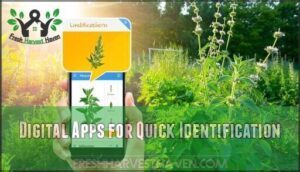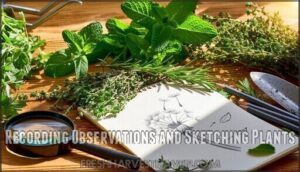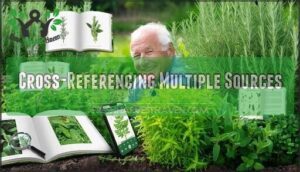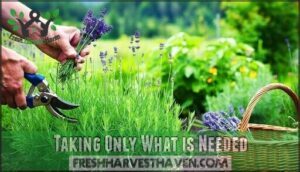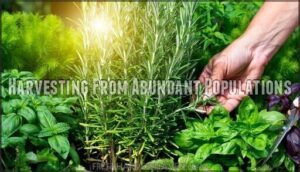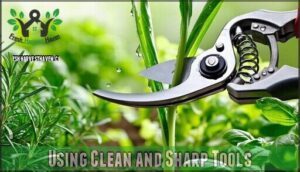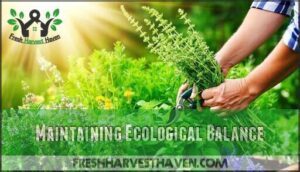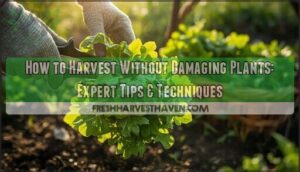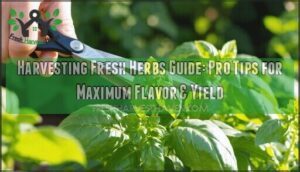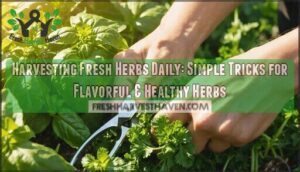This site is supported by our readers. We may earn a commission, at no cost to you, if you purchase through links.
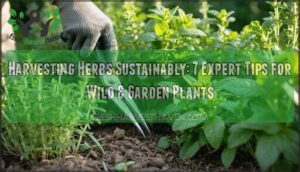 In the context of harvesting herbs sustainably, think like a thoughtful neighbor—only take what you need, and always leave enough for the next visitor.
In the context of harvesting herbs sustainably, think like a thoughtful neighbor—only take what you need, and always leave enough for the next visitor.
Focus on abundant or invasive species, skipping rare or struggling plants.
Use sharp, clean tools and harvest early in the day when herbs are most potent.
Stick to well-established patches and aim to collect less than 10% of each plant, or even less if it’s rare.
Always skip areas near roads or chemicals, and by keeping your gathering mindful and balancing nature’s needs, you’ll find that sustainable harvesting keeps your garden—and your conscience—growing strong.
More secrets ahead!
Table Of Contents
- Key Takeaways
- Sustainable Foraging Practices
- Identifying Wild Herbs
- Best Harvesting Methods
- Herb Harvesting Guidelines
- Maintaining Ecological Balance
- Frequently Asked Questions (FAQs)
- What is the best way to harvest and preserve herbs?
- How to sustainably harvest sage?
- What’s going on with the Herb Hub?
- What is Herb Hub?
- What is an online weed harvesting course?
- How do you protect your herbs from overharvested & poached?
- Are herbal supplements a part of Appalachia’s cultural heritage?
- Why is the herbal hub important?
- How do you harvest herbs without killing them?
- Is growing your own herbs sustainable?
- Conclusion
Key Takeaways
- Focus on picking only abundant or invasive herbs and always leave rare plants alone to keep wild populations healthy.
- Use clean, sharp tools and harvest only what you can use—ideally less than 10% from any patch—to help plants regrow and thrive.
- Avoid foraging near roads, heavily traveled paths, or anywhere herbicides might linger, so your herbs stay safe to eat.
- Make sure you positively identify each plant before you pick, cross-checking with at least three sources for safety and accuracy.
Sustainable Foraging Practices
You’ll discover sustainable foraging when you focus on abundant species like dandelions and nettles while leaving rare plants untouched.
Harvest with heart—choose the plentiful, and let rare plants thrive for tomorrow’s wild beauty
This approach protects native ecosystems and guarantees you’re harvesting responsibly from nature’s most resilient offerings.
Prioritizing Abundant Plant Species
Smart foragers target Invasive Species and Widespread Populations first. These botanical bullies won’t disappear when you harvest them—they’ll actually thank you for the attention while native plants get breathing room.
Focus your sustainable herb harvesting efforts on these resilient champions:
- Nonnative Focus: Dandelions, plantain, and clover thrive under harvesting pressure
- Garden Herbs: Cultivated spaces offer guilt-free abundance for Tending Spaces
- Population monitoring: Choose plants you see everywhere, not rarities
- Herb overharvesting prevention: Stick with species that bounce back quickly
This approach guarantees herb sustainability while actually helping local ecosystems recover.
Maximizing Harvests From Cultivated Spaces
Your garden offers the most reliable source for sustainable herb harvesting without ecological concerns.
Succession planting every two weeks guarantees continuous harvests while leaf trimming techniques like pinching basil tops encourage bushier growth. Propagation methods through stem cuttings expand your supply without purchasing new plants.
Herb cultivation techniques include flower utilization – harvest chive blossoms for mild onion flavor or calendula petals for teas. Root harvesting from mature ginger and turmeric plants provides fresh ingredients year-round.
Follow herb harvesting guidelines by taking only one-third of each plant using clean, sharp tools. This herb garden sustainability approach maintains healthy plants while maximizing yields through proper timing and care.
Responsible Harvesting of Native Plants
When you’re working with native plants, always secure landowner permissions before harvesting.
Ethical considerations demand you take only what you truly need—never more than one percent of any population you find.
Rare species deserve complete protection, so focus your responsible herb collection on abundant natives instead.
To maintain plant health, consider harvest timing strategies.
This approach supports native regeneration and habitat preservation while practicing ethical wildcrafting herbs.
Your wild herb sustainability efforts protect ecosystems for future foragers and maintain biodiversity.
Avoiding Herbicide-Treated Areas
Where should you avoid foraging to protect your health?
Stay clear of roadsides, park edges, and building foundations where herbicide persistence creates lasting soil contamination.
Visual clues like yellowed vegetation signal trouble.
Seek herbicide-free zones with organic practices instead.
Test alternative locations with clean air quality and establish buffer zones from treated areas for safer harvesting.
Identifying Wild Herbs
You can’t safely harvest wild herbs without knowing exactly what you’re picking. Proper identification prevents dangerous mistakes and guarantees you’re collecting the right plants for your needs.
Essential Field Guides and Tools
Building reliable identification skills starts with the right toolkit. Field guide accuracy depends on quality references like Peterson’s thorough medicinal plant guides covering 530+ species with detailed illustrations and descriptions.
Your foraging success hinges on proper equipment and ethical tool sourcing:
- 10x magnifying loupe for examining leaf textures and plant details
- Sharp pruning shears requiring regular foraging tool maintenance
- Sturdy collection bags and protective gloves for safe handling
Clean pruning shears prevent disease transmission between plants while detailed field notes complement digital apps when technology fails. You can find many herb field guides online and in stores. Quality field guides remain your most trusted companions for accurate plant identification in remote locations where digital identification pros can’t help.
Digital Apps for Quick Identification
Beyond traditional field guides, digital plant ID apps give you instant results when you’re standing before an unknown herb.
PlantNet leads with 88% app accuracy for flowers, while LeafSnap follows at 83%. Most apps offer offline access for remote foraging adventures.
These apps, however, can present limitations in identifying species not in their databases.
| App | Flower Accuracy | Key Feature |
|---|---|---|
| PlantNet | 88% | Best overall accuracy |
| LeafSnap | 83% | Reliable consistency |
| iNaturalist | Low individual accuracy | Strong community input |
These digital tools enhance field guides perfectly for confident plant identification.
Recording Observations and Sketching Plants
Your field notebook transforms digital apps into powerful plant identification tools when you sketch what you observe.
Botanical Illustration doesn’t require artistic talent—simple drawings of leaf shapes, flower clusters, and stem patterns create lasting memory anchors.
Focus your Sketching Techniques on key Plant Anatomy features like leaf arrangements, petal counts, and growth habits that separate species.
Smart Observation Journaling captures details cameras miss:
- Growth patterns and seasonal changes throughout the year
- Environmental conditions affecting plant appearance and health
- Exact locations with GPS coordinates for sustainable return visits
Your Field Notes should include weather, soil type, and companion plants growing nearby.
This plant journaling practice sharpens your observation skills faster than relying solely on digital apps.
When you combine sketching with written observations, you’ll develop the expertise to confidently identify herbs without constantly checking field guides.
Cross-Referencing Multiple Sources
Smart plant detectives never rely on just one clue. You’ll need at least three independent sources before harvesting any wild herb. Think of it as data triangulation—each reference point helps confirm what you’re seeing in the field.
Start with field guides, but don’t stop there. Digital apps offer quick checks, but conflicting information appears frequently. Online forums provide real experiences, though you’ll encounter varying expertise levels.
This is where identifying bias becomes vital—some sources push certain viewpoints over safety.
Expert verification through botanists or experienced foragers supports source reliability. This cross-checking approach supports responsible wild herb gathering and ethical harvesting while building your confidence in sustainable herb harvesting practices.
Best Harvesting Methods
Once you’ve identified the right herbs, proper harvesting techniques protect both plant health and your future supply.
The way you cut, when you collect, and how much you take determines whether plants thrive or decline after harvest, which is crucial for maintaining the health of the plants and ensuring a future supply.
Taking Only What is Needed
After identifying your herbs correctly, you’ll need to practice mindful harvesting that protects plant populations for future generations. Think like a careful gardener rather than a collector – your goal is sustainable yield without damaging the ecosystem.
Ethical consumption starts with honest assessment of your actual needs. Calculate weekly herb requirements before you forage. This prevents overharvesting prevention and supports plant regeneration.
Follow these sustainable herb harvesting principles:
- Track actual usage in a harvest journal
- Apply the 10% rule – never take more than one-tenth of available plants
- Match collection amounts to your storage capacity
- Prioritize immediate use over stockpiling
- Focus on abundant species rather than rare finds
Respect limits nature sets. Minimize waste by harvesting only what you’ll realistically use within two weeks.
Harvesting From Abundant Populations
Population monitoring makes harvesting decisions simple. Look for clusters of 20+ healthy plants before collecting anything. These abundant species can handle careful harvesting without ecosystem impact.
This species identification approach protects habitat health while ensuring sustainable herb harvesting. Harvest rotation between areas prevents overharvesting and supports herb regeneration methods. Following these guidelines maintains ethical harvesting practices and minimizes ecosystem impact, which is crucial for ecosystem balance.
Using Clean and Sharp Tools
Your tools are your plants’ best friends. Clean tools prevent disease transmission, while sharp blades create precise cuts that heal quickly.
Sterilize pruning shears with rubbing alcohol between plants for proper tool sterilization. Dull blades crush stems, creating infection-prone wounds that stress plants.
Sharp shears with good blade sharpness guarantee clean cuts, preventing damage and reducing disease risk. Regular tool maintenance keeps your equipment performing well.
Think of it like using a sharp kitchen knife versus a butter knife—the results speak for themselves. Invest in quality pruning shears for disease prevention and healthier harvests.
Consider purchasing new shears for superior cutting.
Harvesting at Peak Potency
Timing your herb harvest correctly separates amateur gardeners from those who create truly potent remedies. Morning harvest delivers peak essential oils concentration, typically between 10 a.m. and noon when dew has evaporated but before afternoon heat diminishes potency.
Growth stage determines flavor intensity and medicinal value. Leaves reach maximum strength during spring’s vigorous growth, while flowers need picking just before full bloom. Roots concentrate their power in fall after energy moves underground.
Harvesting timing varies dramatically by species and compound. Peak harvest times for volatile oils occur right before flowering, but some herbs like calendula benefit from full bloom collection. The best quality is defined by the levels and consistency of desired biochemicals, not necessarily the plant’s size or appearance, so consider biochemical content.
Here’s what intentional harvesting looks like:
- Check plants daily as flowering approaches
- Harvest when leaves appear vibrant and healthy
- Cut stems cleanly with sharp tools
- Process herbs immediately after collection
- Record timing for future sustainable harvest planning.
Smart harvesting techniques respect each plant’s natural rhythm while maximizing herb potency.
Herb Harvesting Guidelines
Beyond basic harvesting techniques, you’ll need to follow specific guidelines that respect both plant communities and traditional practices.
These principles guarantee your herb gathering remains sustainable while honoring the relationship between harvester and plant, ensuring that your actions are in line with traditional practices.
Seeking Plant Permission
Before harvesting, take a moment to connect with the plant through silent prayers or mindful reflection. This spiritual connection establishes plant respect and clarifies your harvest intention. Building reciprocal relationships means acknowledging the gift you’re receiving.
Pause and listen—let gratitude guide your hands as you honor the plant’s generous spirit
Many gardeners find that harvesting before flowering yields the best flavor for leafy herbs.
| Permission Type | Approach | Benefit |
|---|---|---|
| Landowner Communication | Seek Written Consent for private property | Avoids legal issues |
| Public Lands | Check Legal Considerations and permits | Guarantees compliance |
| Plant Communities | Express botanical thanks through gratitude | Honors natural cycles |
| Verbal Agreements | Confirm harvesting boundaries clearly | Prevents misunderstandings |
This intentional approach transforms simple gathering into meaningful stewardship that benefits both harvester and ecosystem.
Collecting Less Than 1% of Plants
Once you’ve got plant permission, stick to the “less than 1%” rule for sustainable herb harvesting. This means you’re leaving almost every plant behind, protecting population health and supporting ecosystem resilience.
Think of it as regenerative harvesting—like taking a single cookie from a giant jar. Minimal impact guarantees long-term sustainability and keeps wild herbs thriving.
This small step in herb conservation practices and herb resource management makes a big difference for plant regeneration and future harvests.
Utilizing All Plant Parts
Root-to-stem eating isn’t just a trendy phrase—it’s a smart way to practice sustainable harvest.
When you use the Whole Plant, you access Root Uses for healing powders, Stem Potential for crunchy salads, and Flower Power for color and flavor.
Leaves brew into teas, while seeds offer Seed Saving and new plants.
Whole plant usage means less waste and more benefits.
Try different harvesting techniques to discover each part’s unique flavor.
By maximizing plant part usage, you support a sustainable harvest and get the most from every herb.
Offering Gratitude to Plants
Once you’ve explored every part of your herbs, pause and consider the value they’ve given.
Respectful Harvesting isn’t just about the plants—it’s about Acknowledging Gifts and building a Reciprocal Relationship with nature.
Honoring Nature and fostering a Spiritual Connection can be simple, but it makes ethical practices feel more meaningful.
Think of it as saying “thanks” to a wise friend who always shares.
Before snipping, mentally ask the plant for permission.
Offer a silent prayer or a small gesture—a drop of water, a gentle touch.
Harvest with intention, taking only what you’ll actually use.
Imagine the plant thriving after your visit.
- Offer a silent “thank you” before you cut
- Leave a few drops of water as gratitude offerings
- Picture the plant regrowing stronger
- Whisper good wishes for its health
- Practice mindful consumption, not just collection
This approach deepens plant respect and supports healthy ecosystems, promoting a sense of gratitude and respect for nature.
Maintaining Ecological Balance
You play a key role in keeping nature healthy when you harvest herbs, so it’s important to avoid taking too much and stick to clean, safe areas.
By rotating your harvest spots and treading lightly, you help plants bounce back and keep ecosystems thriving for everyone.
Avoiding Over-Harvesting and Pruning
A good gardener knows that the one-third rule is like giving your herbs a haircut—not a buzz cut.
Never take more than a third of any plant at one time. These sustainable herb harvesting tips, like regular leaf trimming and smart pruning techniques, keep your herbs healthy and encourage even more growth.
Space out your harvest frequency and use precise cuts to promote plant health. Try succession planting for steady supplies.
Remember, a little careful pruning goes a long way, giving you vibrant, productive herbs all season long, which is the ultimate goal of smart pruning techniques.
Harvesting in Pollution-Free Areas
In terms of Safe Harvesting, location is everything. You want herbs from pollution-free areas, not ones growing by a busy highway or next to a mystery puddle. Think of yourself as a detective, checking clues for clean air, water, and soil.
Here’s your scientific checklist:
- Check Air Quality—if you smell exhaust, move on.
- Inspect Water Sources—no foam, odd colors, or chemical odors.
- Examine Soil—avoid spots with stunted plants or strange discoloration.
- Practice Soil Testing—use a kit for heavy metals before picking.
- Toxin Avoidance—look for dust, residue, or odd leaf textures.
Sustainable herb harvesting means protecting herb biodiversity and ecological balance. To guarantee the best growth, consider soil composition’s PH balance. Environmental stewardship starts with where you pick.
Treading Lightly and Minimizing Impact
Stepping into any wild or garden patch, you want to keep your footprint as light as a feather.
Stick to clear paths to minimize disturbance and preserve roots below.
Sharpened snips help plants heal and regrow, supporting sustainable herb harvesting.
Pause before moving to a new spot—habitat preservation and pollinator protection depend on staying mindful.
Use this table for quick ecofriendly herb practices.
When you harvest with a soft touch, you practice responsible foraging and minimize environmental impact year-round.
Biodiversity preservation
Rotating Harvest Areas for Sustainability
Want your herb patch to thrive year after year? Harvest rotation is your secret weapon. By spreading out where you pick, you give each zone time for soil and plant recovery.
This simple rotation method mirrors nature, keeping soil alive, boosting Ecosystem Health, and protecting fragile populations. Think of it as giving each “room” their turn to rest for Area Regeneration, while you reap Rotational Benefits and preserve herb populations.
Here’s your plan:
- Split your garden into four harvest zones.
- Rotate zones each season.
- Rest each section for two full growing cycles.
- Note which spots yield best.
- Let every area flower—herb biodiversity protection in action.
Frequently Asked Questions (FAQs)
What is the best way to harvest and preserve herbs?
Snip herbs in the early morning with clean, sharp scissors, grabbing only what you’ll use.
Dry them upside down in a cool spot or freeze chopped bits in ice cube trays.
Your future self will thank you!
How to sustainably harvest sage?
Ever wonder if sage can keep thriving after harvest?
Clip just a few stems at a time, always leaving most leaves behind.
Make clean cuts above leaf nodes so the plant keeps growing—sage appreciates a gentle haircut, not a buzzcut!
What’s going on with the Herb Hub?
You’ll find Herb Hub buzzing—new workshops on native pollinator-friendly planting, a seed swap for hardy varieties, and monthly Q&A sessions.
Don’t forget the tip jar; rumor has it, they’re funding a community greenhouse.
What is Herb Hub?
Think of Herb Hub as a greenhouse for knowledge—it helps you grow your understanding of herbs, from plant basics to medicinal uses.
You’ll discover clear, practical tips, honest guidance, and real-world stories, spicing up your learning.
What is an online weed harvesting course?
An online weed harvesting course guides you on safely identifying, collecting, and using common wild plants.
You’ll learn the difference between weeds and edibles, how to avoid pitfalls, and pick up practical tips—no knuckle-busting mistakes required, to ensure a safe and successful experience with edibles.
How do you protect your herbs from overharvested & poached?
Protect your herbs by planting in hidden spots, chatting with neighbors to build watchful eyes, and using signs about sustainable picking.
Only take what you need, share tips with others, and keep the patch healthy for future use, ensuring a healthy environment.
Are herbal supplements a part of Appalachia’s cultural heritage?
You’ll see herbal supplements woven into Appalachia’s cultural heritage, with folks using wild herbs for generations.
It’s more than habit—it’s family, healing, and connection to the land, passed down like beloved stories or secret recipes, which represents a strong sense of healing.
Why is the herbal hub important?
Like a crossroads in a small town, the herbal hub connects folks to knowledge, resources, and safe practices.
You’re not just picking plants; you’re joining a community that helps preserve nature and your own well-being.
How do you harvest herbs without killing them?
Snip just a few leaves or stems with sharp scissors, leaving most of the plant behind—think of it as giving your herbs a quick trim, not a buzzcut.
Harvest in the morning, and never take more than one-third.
Is growing your own herbs sustainable?
Growing your own herbs is sustainable when you harvest lightly and let the plants keep growing.
You’ll avoid overharvesting wild patches and get fresh greens right outside your door—kind of like having your own edible insurance policy.
Conclusion
Like leaving a bit of birthday cake for the next guest, harvesting herbs sustainably means always thinking ahead.
When you focus on abundant species, use sharp, clean tools, and skip rare or chemical-laden areas, you help both your garden and the wild thrive.
Take what you need, log your observations, and thank the plants, these steps let nature keep sharing its rewards, so you’ll keep finding fresh herbs season after season, never shortchanging tomorrow’s harvest.


